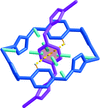issue contents
December 2019 issue

Cover illustration: A structural study of a high-pressure phase of magnesium chloride hexahydrate (MgCl2·6H2O-II) showed symmetry reduction of the crystal structure from its ambient-pressure phase. This change is induced by modification of the hydrogen-bond network. See Yamashita, Komatsu, Hattori, Machida & Kagi [Acta Cryst. (2019), C75, 1605-1612].
research papers
Download citation


Download citation


New CdII and MnII coordination polymers (CPs) have been prepared using 5-[(4-carboxyphenoxy)methyl]benzene-1,3-dicarboxylic acid and 2,2′-bipyridine under hydrothermal conditions. The former CP displays a 3D supramolecular structure extended from 2D layers by intermolecular π–π interactions, while the latter shows a different 3D supramolecular structure extended from 1D ladder chains by intermolecular π–π interactions. The results suggest that the metal ion and π–π interactions play important roles in the design and construction of various CPs.
Download citation


Download citation


The crystal of DL-phenylglycinium trifluoromethanesulfonate monohydrate dehydrates in one step at 353 K and is preceded by a weakening of the aromatic ring–aromatic ring interactions. The loss of water is accompanied by the breakage of medium-strength hydrogen bonds and the rearrangement of ions inside layers. The dehydration process induces a single-crystal-to-poly-crystal transformation.
Download citation


Download citation


Three coordination polymers based on 3,3′-[(5-carboxy-1,3-phenylene)bis(oxy)]dibenzoic acid and 1,10-phenanthroline have been prepared and structurally characterized, and the magnetic properties of the NiII/CoII complexes and the luminescence properties of the ZnII complex were investigated.
Download citation


Download citation


A novel multifunctional 1D→2D interpenetrating CoII–organic framework was successfully constructed using 2-amino-5-sulfobenzoic acid and 1,4-bis[(imidazol-1-yl)methyl]benzene as ligands.
CCDC reference: 1482482
Download citation


Download citation


A structural study of a high-pressure phase of magnesium chloride hexahydrate (MgCl2·6H2O-II) showed symmetry reduction of the crystal structure from its ambient-pressure phase. This change is induced by modification of the hydrogen-bond network.
Download citation


Download citation


The salt bis(tetraphenylarsonium) hexafluoridotechnetate(IV) dihydrate, (AsPh4)2[TcF6]·2H2O, was prepared for the first time from a cation metathesis reaction of (NH4)2[TcF6] in water.
CCDC reference: 1962597
Download citation


Download citation


Three new aminocoumarin derivatives show hydrogen bonds and rich π–π stacking, together with π⋯H interactions. They display absorption maxima in the visible region, attributed to π–π delocalization involving the whole electronic system of the compounds with a considerable charge-transfer character originating from the aminophenyl ring and pointing towards the coumarin system which is characterized by a high electron-accepting character.
Download citation


Download citation


Two isomorphic viologen derivatives both possess only one electron-transfer pathway, but they exhibit different photoresponsive behaviours relating to the distances between the halide anions and the cationic N atoms of 1-(2-cyanobenzyl)-4,4′-bipyridinium.
Download citation


Download citation


The structures of the cocrystalline adducts of 3-nitrophenol with 1,3,5,7-tetraazatricyclo[3.3.1.13,7]decane, 1,3,6,8-tetraazatricyclo[4.3.1.13,8]undecane and 1,3,6,8-tetraazatricyclo[4.4.1.13,8]dodecane are reported. The three cocrystals were obtained by the solvent-free assisted grinding method.
Download citation


Download citation


A multicomponent pharmaceutical salt formed by the isoquinoline alkaloid berberine (BBR) and the nonsteroidal anti-inflammatory drug diclofenac (DIC) was discovered. Five solvates of the BBR–DIC salt were obtained and their crystal structures determined.
Download citation


Download citation


The reactivities of two 20-membered macrocyclic ligands, each containing two N-heterocyclic carbene (NHC) and two amine groups, towards [IrCl(COD)]2 (COD is cycloocta-1,5-diene) were investigated.
Download citation


Download citation


Dinuclear cobalt(II) and nickel(II) complexes were obtained from a mercaptoacetic acid substituted 1,2,4-triazole ligand. The complexes show distinct supermolecular structures because of the different coordinated and guest molecules, and both show potent urease inhibitory activity.
Download citation


Download citation


A novel (3,6)-connected CdII coordination polymer based on an ether-linked tricarboxylate ligand has been synthesized, structurally studied and shows good stability and promising luminescence sensing properties.
CCDC reference: 1966309
Download citation


Download citation


The possibility of a one-stage solvent-free stereoselective synthesis of a spirocyclic quinazoline derivative is described for the first time. An X-ray diffraction study of the crystal structure of the chiral spirocyclic compound obtained was carried out and its porosity was studied.
CCDC reference: 1950034
Download citation


Download citation


4-(Pyridin-2-yl)pyrimidin-2-amine is structurally distinct with respect to the position of the N atom in the pyridine ring compared with the structure of imatinib, which is an excellent inhibitor of Bcr-Abl tyrosine kinase. The interaction energies of this relatively small ligand in the active pocket of the protein indicate its potential.
CCDC reference: 1966319
Download citation


Download citation


Three coordination polymers self-assembled from a new asymmetrical oxadiazole-containing ligand and AgPF6, CuI and Cd(NO3)2 are reported, together with their structural characterization and photoluminescence properties.


 journal menu
journal menu

































